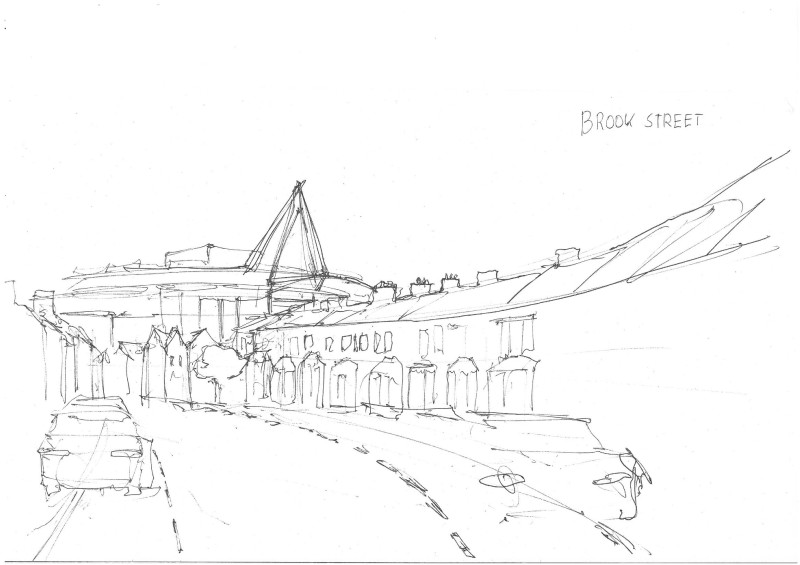Although being in Cardiff University only several days I have a feeling of exploring quite a big part of the city. This premise quickly faded away after yesterday receiving the task named “Watercourse Transect”. Its aim was to explore the terrains, on which in the old times flowed the Canna river; today all mostly covered with dwellings.
The Experience of Walking
But how the architect can bring such abstract term as “exploring” into reality? What can he really gain from the activity so simple as walking? First step is the travel preparation. One hour of laborious studying maps provides the architect with some expectations and precautions about the tour. Some might say that Street View in Google Maps is now such a powerful tool, that it becomes meaningless to go out of house; but it’s not. The myriad of information that we sense during the walk doesn’t confine merely to our eyes.
When the architect walks he hears the subtle sounds of driven cars on the motorway and stepping feet of a boy walking across the pavement. He smells as well the pleasant tone of chopped timber and the harsh fumes and smokes of the road. He also touches the stone-made facade of the buildings and handle of doors. Without plunging into deeper description of the rest of our not so well-known senses (to which we can also include the ability to feel tautness of our muscles, the feeling of pain, the feeling of what’s heat or cold and even the feeling of magnetic field of our planet and the feeling of electricity in the air) the architect sees. Seeing is a wonderful tool of the architect and though the eyes are one of the best devices of our body, skin, ears, nose, tongue, hairs – they all contribute to our perception of the world.
In the end of the day, such experiences may be taken as a source of inspiration in the same way as the English tradition of walking inspired the landscape architects and painters. The emergence such masterpieces as John Constable’s oil paintings, Charles Dickens’s London descriptions or William Kent’s garden compositions shouldn’t surprise in the country of which attitude towards walking is of almost religious magnitude (Alice Foxley, “Distance & Engagement. Walking, Thinking and Making Landscape”, 2011).
The Landaff Cathedral
We started our journey from the site where the former river had its source. While our bus was going higher and higher through the curling road, the view over the forest was becoming more vivid. Our destination’s tower – the Landaff Cathedral – was standing in a silent magnitude over the see of trees. After disembarkment we strode down the small path confined by a stone-made gothic portal on the right and a small rocky wall on the left. Suddenly, we are stunned by the enormous in scale and at least twice as high as the highest trees nearby tower, on top of which giant spire rises. Soon it becomes clear to us that this experience was formerly directed. We reach the main axis of the cathedral we see a surprise – the second tower is only about half as tall as the first one. Norman architecture on the left and its aggressive stone-made walls come into play with the elegance of Victorian bricks on the right.
Shape of Brook Street as a legacy of the old times
Now we are heading Brook Street, the place near which The Canne was flawing into the main river in Cardiff – the Taff. The site in which our street is located consists mostly of small houses, what stands in contrast with the big dwellings which we left not so long ago behind us. What came to my mind is the Industrial History of this place which I read in the briefing from our school. The Taff along with the Ely was on of the most important communication track, on which Cardiff’s Coal export was based. The small houses must have been once dwelled by the fabric workers.
The whole Brook Street traces a slight curve which leads the walker to the river itself. The curve long enough to hide the viewpoint at the end of the street; bearing expectations about the lavish sight over the river and the soften reflection of the Millennium Stadium on it the street provokes specific suspense. Something unexpected suddenly crosses my mind – the curling form of the street bears resemblance to the shape of the departed river. It looks like the river itself before passing away left sign after itself by sculpting newly built dwellings, which now stand as reminiscence of the old days. Passing next and next houses I am feeling excitement and can take pleasure from the miscellaneousness of the place.
Drawings
I hope that some part of the spirit of described places can be conveyed by the visual forms of expression. Sketches were produced on A4; the technique is a black pen.




